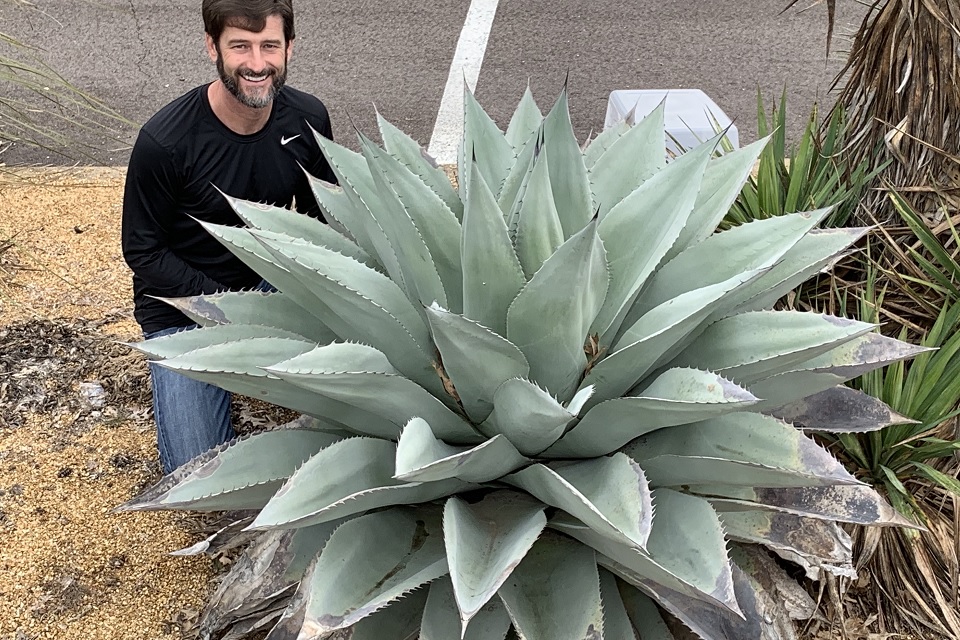
Submitted by Jason Reeves, research horticulturist, University of Tennessee Gardens, Jackson
Up until about 15 years ago, only a handful of agaves were available that were hardy to zero degrees. On top of that, they were miniscule at only 3 to 10 inches tall and were not overly showy. They were nothing to get excited about.
Whale’s tongue agave (Agave ovatifolia) was found in the mid 1980s growing in the Sierra de Lampazos Mountains in Mexico at elevations from 3,700 to 7,000 feet. It had not previously been described in any literature. In 2001 it was given the species name ovatifolia.
A fast-growing succulent, whale’s tongue agave is the personification of exotic beauty. The imposing blue leaves are arranged in a spiral—forming a single, symmetrical rosette. Whale’s tongue is grown from seed or tissue culture. Those grown from tissue culture (for example, ‘Frosty Blue’ and ‘Vanzie’) are genetic clones and look exactly alike. Those grown from seed will differ in color, shape and size from plant to plant.
Colored in shades of blue, the leaves are cupped and can vary from long and narrow (24 inches x 8 inches) to relatively short and broad (18 inches x 10 inches). The grand, undulating leaves are lined with deep mahogany curved teeth measuring one-quarter to one-half inch in depth and end in a terminal 1- to 2-inch spine. Adding depth of beauty, a shadow of these spines is left on each leaf from the emerging process. Agave ovatifolia will grow to 3 to 4 feet tall and 4 to 6 feet wide in 5 to 8 years, especially with summer water.
These plants end their life after 10 to 20 years with a spectacular show by producing a flower stalk 10 to 15 feet tall that draws a variety of bees. This stalk has many branches adorned with densely clustered chartreuse flowers, which are held upright, reminiscent of a candelabra. Unfortunately, the growing season in Tennessee is not long enough for the resulting seed pods to develop and mature before frost. Unlike most agave, it does not produce offsets (pups). Therefore, after flowering you will need to source another plant.
Whale’s tongue grows happily in soil with average to low fertility in settings with full sun to dappled shade. They are drought tolerant, but grow much faster with supplemental water in the summer. Even though they are more adaptable to damp, cool climates than other agaves, good draining soil is the key to success. They are best planted on a slope or in a bed amended with crushed gravel.
It is best to plant the zone 6b agave during the months of May through July, which allows time for the roots to become established before the following winter. The young plant should be shielded from winter rain for the first and second winters. At the UT Gardens, Jackson, we place a shallow clear tub (18 inches x 24 inches) upside down over the plants from December to early April. The tub has a dozen half-inch holes drilled near the top to allow air to escape on warm days. The tub should be elevated 4 to 6 inches above the soil for airflow. The goal is not to keep the plant warm but dry. In the fall and winter, be sure to remove any fallen leaves and debris that collect on or around it.
This striking succulent makes an exotic specimen in the garden and can be even more impressive when used in mass plantings. We enjoy them in our gardens and know you will, too!
The UT Gardens includes plant collections located in Knoxville, Crossville and Jackson. Designated as the official botanical garden for the State of Tennessee, the collections are part of the UT Institute of Agriculture. The Gardens’ mission is to foster appreciation, education and stewardship of plants through garden displays, educational programs and research trials. The Gardens are open during all seasons and free to the public. For more information, see the Gardens website: utia.tennessee.edu/state-botanical-garden/.
###
Planting Instructions:
For a large area remove the existing soil approximately 12 to 18 inches deep. Refill with a mix made of one-part excavated soil and three-parts crushed rock while building the entire area up 8 to 12 inches above the original level (grade). Crushed pea gravel, granite chicken grit and PermaTill®/ VoleBloc all work well. Mulch the plants with gravel instead of traditional mulch. When preparing the ground for a single plant dig a bowl-shaped hole 16 inches deep, fill with the soil-gravel mix and then mound 8 inches of above that. Envision a 2-foot sphere of the soil-rock mix with two thirds of the sphere in the ground and the remaining one third above. Then plant the agave at the top of the mound.